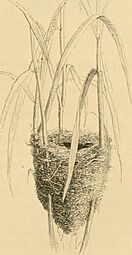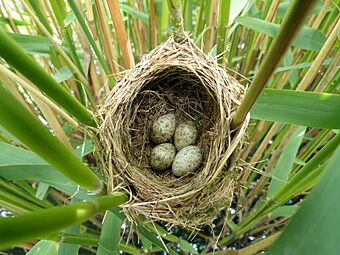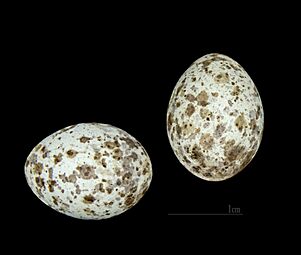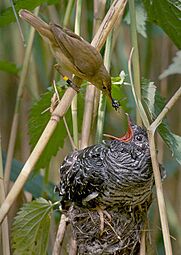Common reed warbler facts for kids
Quick facts for kids Common reed warbler |
|
|---|---|
 |
|
| Conservation status | |
| Scientific classification | |
| Genus: |
Acrocephalus (bird)
|
| Species: |
scirpaceus
|
| Subspecies | |
|
See text |
|
 |
|
| Distribution
Breeding range Resident year-round Passage Non-breeding range |
|
The common reed warbler (Acrocephalus scirpaceus) is a small bird found in many parts of the world. It belongs to a group of birds called "Old World warblers." These birds are known for their songs.
Common reed warblers breed across Europe and into western Asia. They are migratory birds, which means they fly long distances. During winter, they travel to sub-Saharan Africa. Some common reed warblers also live in Africa all year round.
Contents
About the Common Reed Warbler
The common reed warbler was first officially described in 1804. This was done by a French naturalist named Johann Hermann. He gave it the scientific name Turdus scirpaceus.
Later, the bird was placed into the genus Acrocephalus. This genus name comes from Ancient Greek words. Akros means "highest," and kephale means "head." The specific name scirpaceus comes from Latin. It means "reed," which makes sense because these birds love reeds!
There are different types of common reed warblers. These are called subspecies. For example, the ones in Europe are A. s. scirpaceus. Others live in different parts of Africa and Asia. Sometimes, the reed warblers found in Spain and Africa are even considered a separate species. This bird is called the African reed warbler (Acrocephalus baeticatus).
What Does It Look Like?
The common reed warbler is a medium-sized bird. It is about 13 cm (5 inches) long. Its wingspan is between 17 and 21 cm (6.7 to 8.3 inches).
Adult birds have a plain brown back. Their belly is a light, buffy color. Their forehead is flat, and their beak is strong and pointed. Male and female common reed warblers look the same. Young birds have a richer buff color on their underside.
This bird looks a lot like the great reed warbler. But the great reed warbler is bigger. It also has a stronger stripe above its eye.
Where Do They Live?
This small passerine bird, which means it's a perching bird, lives almost only in reed beds. These are areas filled with tall, hollow-stemmed plants called reeds. You can often find them near water. They might also live in damp, bushy areas.
How They Live and What They Eat
Food and Feeding Habits
Like most warblers, the common reed warbler is insectivorous. This means it mostly eats insects. But sometimes, it will also eat plant material, like berries.
Raising a Family
Male common reed warblers usually arrive at the breeding grounds first. They come about two or three weeks before the females. Most common reed warblers are monogamous. This means they have one partner during the breeding season.
The first eggs are laid around the end of April. The nest is usually built in plants over water. Reeds are a favorite spot for their nests. The nest is shaped like a deep cup. It is usually about 65 cm (25 inches) above the water. The female builds the entire nest herself. She uses grass, reed stems, and leaves. Then she lines it with finer materials like hair.
A female common reed warbler lays three to five eggs. She lays one egg each day. The eggs are a very pale green color. They have speckles and blotches of olive green or gray. Both parents take turns sitting on the eggs. This is called incubation. The eggs hatch after 9 to 12 days.
Once the chicks hatch, both parents feed and care for them. The young birds leave the nest after 10 to 12 days. This is called fledging. But their parents continue to feed them for another 10 to 14 days. About one-third of common reed warbler pairs will raise a second group of chicks in the same year.
The common reed warbler is sometimes tricked by the common cuckoo. The cuckoo is a brood parasite. This means the cuckoo lays its eggs in the reed warbler's nest. Then the reed warbler parents raise the cuckoo chick as their own!
Gallery
-
Common cuckoo chick fed by reed warbler adult







